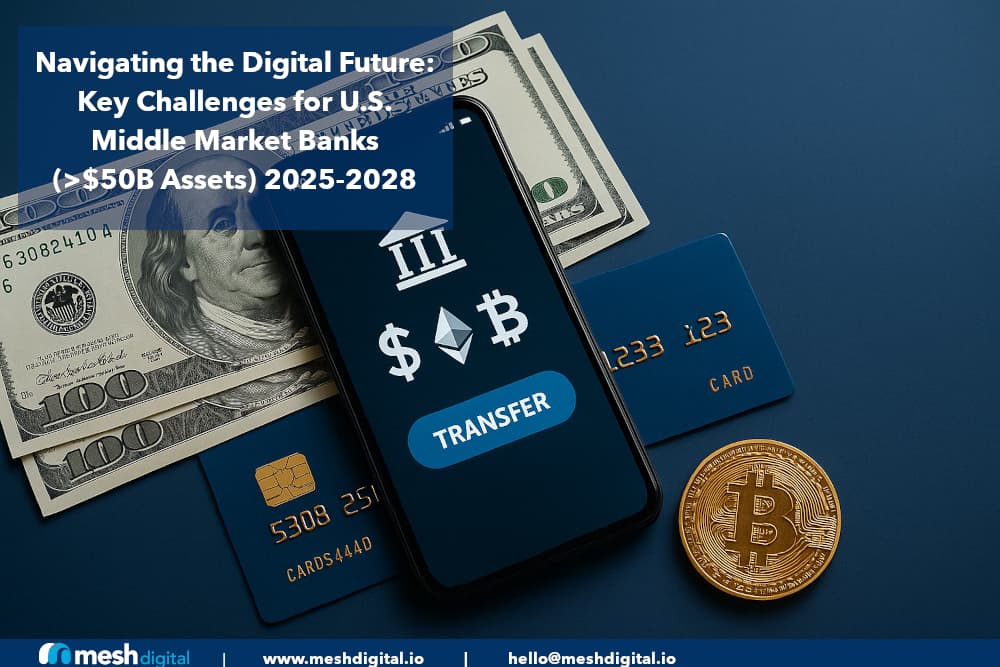Navigating the Digital Future: Key Challenges for U.S. Middle Market Banks (>$50B Assets) 2025-2028
U.S. middle market banks face regulatory, tech, and competitive pressure through 2028. Key priorities include digital modernization, Basel III compliance, cybersecurity, and adapting to shifting customer expectations, with boutique consultancies playing a vital strategic role.

Abstract
This research examines critical challenges facing U.S. middle market banks with assets exceeding $50+ billion from 2025 to 2028. It identifies key areas of concern, including compliance pressures arising from the Basel III endgame regulatory framework, increasing competition from fintechs and neobanks, and the urgent necessity for modernizing legacy IT infrastructure. The analysis further explores escalating cybersecurity threats, economic uncertainties impacting net interest margins, demographic shifts toward digital banking preferences among younger customers, and broader regulatory changes extending beyond Basel III. Additionally, strategic implications of embedded finance, the importance of ESG integration, and the harnessing of emerging technologies such as artificial intelligence, cloud computing, and blockchain are discussed. The paper concludes by emphasizing strategic imperatives that banks must undertake, highlighting the role of digitally-led boutique consultancies in providing essential insights and facilitating adaptive strategies for sustainable growth and long-term competitiveness.
Executive Summary
As the financial landscape evolves rapidly, U.S. middle market banks—those regional and super-regional institutions with assets exceeding $50 billion—find themselves at an inflection point. The period from 2025 to 2028 promises opportunities for growth but also presents complex challenges. Institutions such as; Truist, KeyCorp, Fifth Third, Regions, and Citizens Bank must navigate this transformation adeptly to secure their future competitiveness and sustainability.
Basel III Endgame: Capital and Compliance Pressures
The Basel III endgame regulatory framework, effective July 2025, poses significant capital and operational implications. With anticipated increases in capital requirements by approximately 10% and substantial changes to risk-weighted asset (RWA) calculations, banks must recalibrate their capital planning strategies significantly (PwC, 2024; Derivsource, 2024).
Digital Competition: Fintechs and Neobanks
Emerging fintechs and neobanks continue to aggressively expand their market presence. With the global neobanking market forecasted to grow at a CAGR of approximately 40-50% through 2034, traditional banks face intensified competition in customer acquisition and retention, particularly among digitally native demographics (Precedence Research, 2025).
Legacy System Modernization
A pressing and persistent challenge is the modernization of outdated legacy IT infrastructures. These archaic systems significantly hinder operational agility, innovation capacity, and scalability. Many regional banks still rely on technologies developed decades ago (internally or via fintech providers), making integration with modern digital services cumbersome and costly (Jelvix, 2025).
Cybersecurity: An Escalating Threat Landscape
To put it mildly, Cyber threats targeting financial institutions are increasingly sophisticated, leveraging advanced technologies like artificial intelligence (AI). Banks must continually strengthen cybersecurity protocols to combat evolving threats such as ransomware attacks and advanced persistent threats (APTs) (First Bank and Trust, 2025).
Net Interest Margin Pressures Amid Economic Uncertainty
Fluctuating interest rates and heightened competition for deposits place continuous pressure on net interest margins. With persistent inflation expected to remain above the Fed’s 2% target through 2026 (with potential for stagflation), the anticipated interest rate environment suggests continued margin compression (American Bankers Association [ABA], 2025; Deloitte, 2025).
Demographic Shifts: Catering to Younger Generations
Younger customers, primarily Millennials and Gen Z, overwhelmingly prefer digital banking platforms. Approximately 64-68% of these groups prioritize mobile banking as their primary financial management tool (American Bankers Association [ABA], 2024).
Navigating Broader Regulatory Changes
Regulatory changes extend beyond Basel III, encompassing evolving stress test methodologies, liquidity requirements, and consumer protection standards. With the implementation of rules governing personal financial data rights under Dodd-Frank Section 1033, banks must establish secure APIs to comply with open banking mandates (American Bar Association, 2025).
Talent Acquisition and Retention in Tech
As banks increasingly digitize, attracting and retaining technology talent becomes paramount. Young professionals prioritize workplaces that offer flexible arrangements, robust professional growth in emerging tech fields, and a collaborative, innovation-driven culture (Truist Bank, 2025). Additionally, young professionals are likely to come out of academia with only cloud native, even solely server-less computing skills. Creating an immediate skills gap to the "legacy" environments which includes not just mainframes, but can virtual machines, and container technologies that have been prevalent for decades.
Strategic Branch Network Optimization
Digital adoption has reduced the necessity for extensive physical branch networks, yet branches remain essential for certain customer interactions. Banks must adopt data-driven strategies to optimize branch locations, service offerings, and formats, ensuring alignment with local market conditions and customer preferences (Oliver Wyman, 2025).
Embedded Finance and Market Disruption
Embedded finance—integrating financial services into non-financial platforms—is rapidly reshaping the competitive landscape, with platforms like Stripe Treasury exemplifying its disruptive potential (Alloy, 2025).
Environmental, Social, and Governance (ESG) Integration
ESG considerations are increasingly influential, driven by investor demands and regulatory scrutiny. Banks are under pressure to transparently report ESG practices and enhance sustainability and community engagement initiatives (S&P Global, 2025), less so DEI initiatives at the time of this research.
Harnessing Emerging Technologies: AI, Cloud, and Blockchain
Artificial intelligence and cloud computing stand at the forefront of banking innovation, promising substantial operational efficiencies and personalized customer experiences (FIS, 2025). Blockchain, though still maturing, offers potential benefits in cross-border payments and transaction security, warranting careful exploration and selective implementation (ULAM LABS, 2025).
Conclusions:
The next three years present a complex and dynamic environment for U.S. middle market banks. The challenges identified, particularly the implementation of Basel III endgame, the intense competition from fintech and neobanks, and the critical need to modernize legacy systems, require immediate and strategic attention. These banks must also proactively adapt to evolving customer preferences, navigate a shifting regulatory landscape, and address emerging threats like cybersecurity. A digitally-led boutique consultancy, with its deep understanding of the banking industry and expertise in digital transformation and regulatory compliance, can serve as a valuable partner in helping these institutions not only overcome these challenges but also capitalize on the opportunities presented by technological advancements and changing market dynamics. By providing tailored, digitally-driven solutions, the consultancy can empower these banks to enhance their competitiveness, improve their operational efficiency, and ultimately achieve sustainable growth in the years to come.
References
Alloy. (2025). Embedded finance: A deep-dive for banks and fintechs. Retrieved from https://www.alloy.com/guides/understanding-embedded-finance
American Bankers Association (ABA). (2024). Consumer survey banking methods 2024. Retrieved from https://www.aba.com/about-us/press-room/press-releases/consumer-survey-banking-methods-2024
American Bankers Association (ABA). (2025). Economic advisory committee forecast March 2025. Retrieved from https://www.aba.com/about-us/press-room/press-releases/economic-advisory-committee-forecast-march-2025
American Bar Association. (2025). The next wave of open banking: New rules on personal financial data rights. Retrieved from https://www.americanbar.org/groups/business_law/resources/business-law-today/2025-march/new-rules-personal-financial-data-rights/
Derivsource. (2024). Basel III endgame: Regional US banks must prepare for compliance. Retrieved from https://derivsource.com/2024/03/27/basel-3-endgame-regional-us-banks-must-prepare-for-compliance-murex/
Deloitte. (2025). 2025 banking and capital markets outlook. Retrieved from https://www2.deloitte.com/us/en/insights/industry/financial-services/financial-services-industry-outlooks/banking-industry-outlook.html
FIS. (2025). Four key emerging technologies for growth-oriented regional and community banks. Retrieved from https://www.fisglobal.com/insights/four-key-emerging-technologies-for-growth-oriented-regional-and-community-banks
First Bank and Trust. (2025). Cybersecurity in 2025: What financial institutions need to know. Retrieved from https://www.firstbank.com/resources/learning-center/cybersecurity-in-2025-what-financial-institutions-need-to-know/
Jelvix. (2025). Upgrading banking legacy systems: Pros and cons. Retrieved from https://jelvix.com/blog/how-to-modernize-legacy-core-banking-systems-a-full-guide
Oliver Wyman. (2025). Bank branch network optimization. Retrieved from https://www.oliverwyman.com/our-expertise/insights/2023/nov/bank-branch-network-optimization.html
Precedence Research. (2025). Neobanking market size, share, and trends 2025 to 2034. Retrieved from https://www.precedenceresearch.com/neobanking-market
PwC. (2024). Basel III endgame: The next generation of risk-weighted assets. Retrieved from https://www.pwc.com/us/en/industries/financial-services/library/basel-iii-endgame.html
S&P Global. (2025). ESG reporting for regional banks. Retrieved from https://www.spglobal.com/esg/case-studies/a-regional-bank-embraces-esg-reporting
Truist Bank. (2025). Digital transformation strategies for business growth. Retrieved from https://www.truist.com/resources/commercial-corporate-institutional/strategic-advice/articles/digital-transformation-strategies-for-business-growth
ULAM LABS. (2025). Blockchain in banking: Use cases and examples. Retrieved from https://www.ulam.io/blog/blockchain-in-banking-use-cases-and-examples
